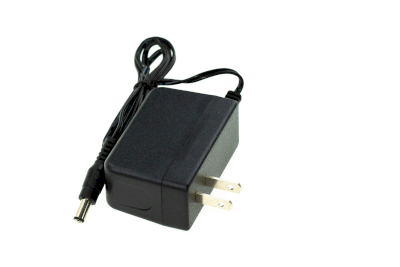What Is an AC Adapter
 An AC (alternating current) adapter is a device that converts AC power to DC power between a power outlet and an electronic device.
An AC (alternating current) adapter is a device that converts AC power to DC power between a power outlet and an electronic device.
AC power is supplied as commercial power from power companies to power outlets in ordinary homes. Since common electronic equipment operates on DC voltage, it must be converted from AC power to DC power. Large household appliances that do not need to be carried around have conversion circuits built in beforehand.
On the other hand, electronic devices that are often carried around do not have built-in conversion circuits for portability. Against this background, AC adapters are used to convert AC power into DC power.
Uses of AC Adapters
AC adapters are widely used in our daily lives. Examples include smartphones, tablets, game consoles, and laptop computers.
AC adapters are often used in mobile devices that are small enough to be carried around and are also useful for reducing the weight and safety of the device itself. By separating the main body of the device and the conversion circuit, the weight is reduced, and user safety is ensured by converting high-voltage commercial power to low-voltage.
In addition to 100V and 200V commercial power sources, power can also be supplied from automobiles and airplanes if the appropriate adapters are provided for input and output, making it a highly versatile product that can supply power without being tied to a specific power source.
Principle of AC Adapters
AC adapters generally receive AC current from an input power source first by means of an AC pin. The current passes through a fuse and flows into a line filter. The line filter reduces the noise caused by the current change.
The current then flows into the diode for full-wave rectification. This mechanism converts the negative voltage input from the power supply into a positive voltage, which is then rectified and changed into direct current.
However, since the current rectified by the diode is not a perfect DC, the next mechanism of the electrolytic capacitor into which the current flows smooth the wave of electricity into a wave closer to a straight line.
The current converted to DC then enters the transistor, where it is converted to a square wave to maintain a stable output voltage. The current converted to a square wave enters the transformer and is adjusted to the optimum voltage. Finally, it is further smoothed by an electrolytic capacitor on the output side.
The AC adapters generate stable direct current by repeating the above process.
Structure of AC Adapters
AC adapters consist of a power plug, a main body, and an output connector.
The power plug of the AC adapters is the part that plugs into the wall outlet. The shape of the plug is standardized by regional standards, and if you want to use the AC adapter plug outside your home country, you will need a separate conversion adapter.
The body of the AC adapters contains a circuit that converts AC power into DC power. The rectifier and stabilizer circuits are the functional parts of the AC adapters; the larger the output power of the AC adapters, the larger the circuits and the larger the size of the body.
The output connector is the part that connects to the electronic device. There are various types of connectors, including standardized connectors and connectors that are unique to the manufacturer.
Types of AC Adapters
There are two types of AC adapters: switching type and transformer type.
1. Switching Type AC Adapters
Switching-type AC adapters have become mainstream since the 2000s and are said to have originated in the 1960s when they were developed by the National Aeronautics and Space Administration (NASA) as a power source for rockets.
In addition to being compact and lightweight, these power adapters are waste-free and highly efficient because they use transistors and other control circuits to adjust the pulse width and stabilize the voltage.
2. Transformer-Type AC Adapters
Transformer-type AC adapters are also known as linear or dropper-type adapters. They have been in use since before switching AC adapters became popular, and are inexpensive AC adapters with simple control circuits. It is also a large and heavy adapter that uses a power transformer with a structure of coils wound around an iron core.
On the other hand, compared to switching-type adapters, AC adapters are less prone to noise and are used for audio equipment and medical equipment.
How to Choose AC Adapters
When selecting AC adapters, check the label on the AC adapter itself and the rated voltage of the connected device. The conversion method and type of output connector must also be compatible.
Since AC adapters are power supply devices, if they are not used properly, they can cause not only malfunctions of the adapter and equipment but also accidents such as fires.
Generally, the model name and model number are indicated on the labeling. In addition, I/P, O/P, L.P.S., plug polarity, and many other information are listed.
1. I/P and O/P
I/P indicates the input voltage, which ranges from 110V to 240V, and the voltages handled vary from country to country.
O/P indicates the output voltage.
2. L.P.S
L.P.S. stands for “Limited Power Source” and refers to power supplies with restrictions on maximum output voltage, output current, and power rating, as specified in the IEC60950 international standard.
3. Plug Polarity
The polarity of a plug indicates the outer and inner diameters of the plug, which are indicated as center plus and center minus. Most adapters available on the market are center-positive. However, if an adapter with a negative marking is mistakenly inserted into an adapter with a positive marking, it may cause equipment failure. Therefore, the polarity of the plug must also be checked.